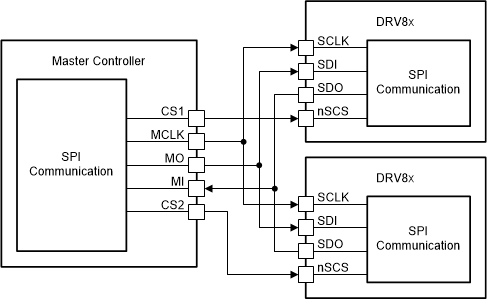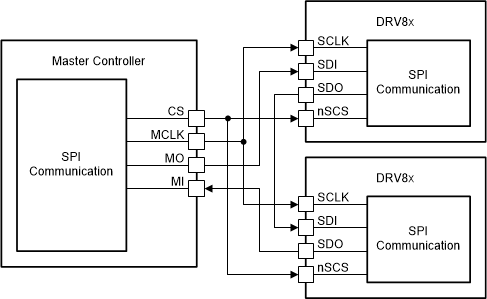SLVSG24C November 2021 – November 2022 DRV8244-Q1
PRODMIX
- 1 Features
- 2 Applications
- 3 Description
- 4 Revision History
- 5 Device Comparison
- 6 Pin Configuration and Functions
-
7 Specifications
- 7.1 Absolute Maximum Ratings
- 7.2 ESD Ratings
- 7.3 Recommended Operating Conditions
- 7.4 Thermal Information
- 7.5
Electrical Characteristics
- 7.5.1 Power Supply & Initialization
- 7.5.2 Logic I/Os
- 7.5.3 SPI I/Os
- 7.5.4 Configuration Pins - HW Variant Only
- 7.5.5 Power FET Parameters
- 7.5.6 Switching Parameters with High-Side Recirculation
- 7.5.7 Switching Parameters with Low-Side Recirculation
- 7.5.8 IPROPI & ITRIP Regulation
- 7.5.9 Over Current Protection (OCP)
- 7.5.10 Over Temperature Protection (TSD)
- 7.5.11 Voltage Monitoring
- 7.5.12 Load Monitoring
- 7.5.13 Fault Retry Setting
- 7.5.14 Transient Thermal Impedance & Current Capability
- 7.6 SPI Timing Requirements
- 7.7 Switching Waveforms
- 7.8 Typical Characteristics
- 8 Detailed Description
- 9 Application and Implementation
- 10Power Supply Recommendations
- 11Layout
- 12Device and Documentation Support
- 13Mechanical, Packaging, and Orderable Information
Package Options
Mechanical Data (Package|Pins)
Thermal pad, mechanical data (Package|Pins)
- DGQ|28
Orderable Information
8.5.3 SPI Interface for Multiple Peripherals
Multiple devices can be connected to the controller with and without the daisy chain. For connecting a 'n' number of devices to a controller without using a daisy chain, 'n' number of I/O resources from controller has to utilized for nSCS pins as shown in Figure 8-11. Whereas, if the daisy chain configuration is used, then a single nSCS line can be used for connecting multiple devices. Figure 8-12
 Figure 8-11 SPI Operation Without Daisy Chain
Figure 8-11 SPI Operation Without Daisy Chain Figure 8-12 SPI Operation With Daisy Chain
Figure 8-12 SPI Operation With Daisy Chain